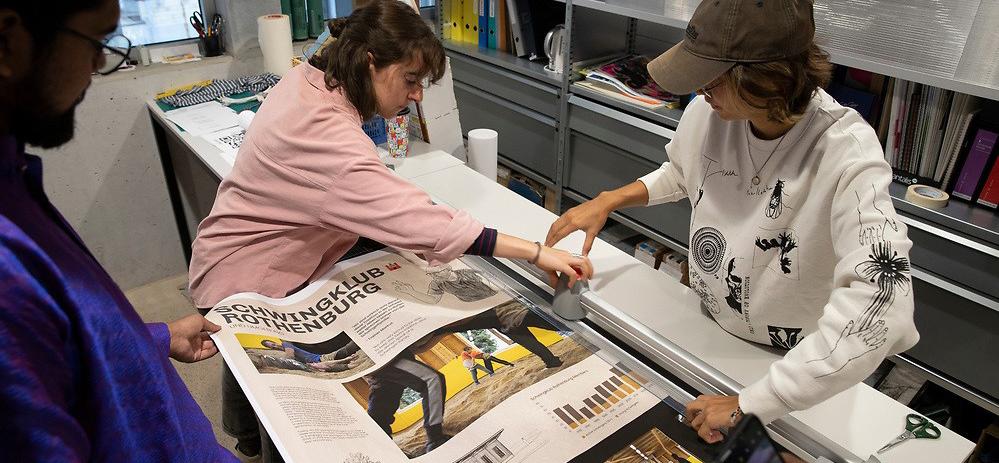MFA Program: Areas of Study
MFA Areas of Production
Each graduate student adds to their pre-existing media skills by selecting two new production areas of study. These production areas become the core of your first two years, with the third year focused on thesis production. A faculty committee of faculty members advises in formulating your individual course plans.
View Full Curriculum Details in the Academic Catalog
Production areas include, but are not limited to:
Animation
Explore animation for educational, entertainment and game design purposes. Emphasis on 2D and 3D computer animation as well as experimental animation. Ancillary courses/experiences also provide an understanding of project management, visual storytelling, and sound for moving image.
Documentary
Explore community, corporate and/or educational production intended for social change and community awareness. Emphasizing both local and international projects, additional faculty and resources come from the WOUB Center for Public Media and the Barbara Geralds Institute for Storytelling and Social Impact.
Data Visualization & Infographics
Gain a comprehensive understanding of information design at the highest level. Learn how to use diagrams, maps and charts to explain and inform, through a multi-platform approach with an emphasis on bridging the gap from big data to compelling and accessible visualizations.
Generative AI and Intelligent Experience (IX)
Explore the transformative potential of Generative AI and Intelligent Experience design through tools and techniques such as natural language processing, text-to-image and video generation, AI-driven storytelling, adaptive user interfaces, emotion recognition systems, and predictive analytics. Develop innovative, user-centric applications that merge creativity and functionality, reshaping how people interact with digital ecosystems.
Interactive Web Design
Study design for web and mobile with a focus on user experience and information architecture. Using code and responsive design, students learn to communicate through interactive sites with a focus on the audience and user first, as well as design fundamentals such as typography, project workflow and front-end design.
Photojournalism
Learn to tell stories through still images and video, focusing on in-depth, intimate moments through documentary photography. By creating single images, documentaries, photo stories and essays, students learn to use photography and video as a communication tool to show others situations, places, events and people.
Publication Design
Tell stories through design and typography with the goal of creating dynamic and engaging publications that are online, in tablet form or in print. Whether their focus is newspaper design or magazine editorials, students learn to communicate with an audience through strong design fundamentals.
Sound Design
Develop the conceptual, technical, and compositional skills of a sound designer by studying sound principles and audio production techniques including field recording, ADR and Foley, and surround sound. Students learn to design sound environments for animation, games, film and video.
Studio Photography
Students learn the business aspects of operating a photographic studio while focusing on photographing a wide variety of content including: advertising, product and still-life, fashion and portraiture, architectural and interior design; as they develop a forward-facing approach to working with clients.
Video Game Design
Emphasizing both the theory and skills needed to create dynamic, immersive environments for narrative, non-fiction and educational use. Students collaborate to explore and produce effective interactive work. This holistic approach includes curriculum focused on game design, programming, sound design and entrepreneurship.
Virtual and Augmented Reality
Harness the possibilities of Virtual Reality and cinematic VR utilizing a variety of tools including immersive and interactive audio, 360-degree video, motion capture and avatar creation, digital game technologies, and both animated and haptic interfaces.
Contextual Areas
Students in the MFA program declare a Cognate Area outside of their production skills to contextualize their studies and inform their intended career path. Cognate areas might include art history, communication theory, educational technologies, film history, health communication, media studies, sociology, philosophy, public media or a wide variety of humanities areas — anything that’s not production!
Experiential Learning

Hands-on, experiential projects are a required part of this program. Students must engage in collaborative projects such as grant-funded faculty initiatives, projects through the Game Research and Immersive Design (GRID) Lab, Barbara Geralds Institute for Storytelling and Social Impact, WOUB Public Media, the Soul of Athens, or practicum projects through the Scripps College of Communication or the Chaddock + Morrow College of Fine Arts. International experiences and professional externships are also encouraged in this area.
Successful completion of at least eight credit hours of Experiential Learning Courses will serve as confirmation that students are prepared for their thesis projects.
Teaching

Teaching is an important part of our program, as the process of teaching helps to solidify intent, process and purpose in the creative individual. Opportunities exist to teach online, face-to-face, lecture, laboratory and seminar classes at the undergraduate level. Qualified students will have the ability to serve as teaching assistant and instructor of record during their time in the program, encouraging them to gain teaching experience and guidance so that they may pursue careers in academia.
